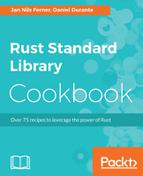At the top, we define our structures. Post[11], NewPost [20], and UpdatedPost [29] all just represent convenient ways to handle the different requirements of the API. The particular JSON API we are interacting with uses camelCase variables, so we need to specify this on every struct, otherwise serde won't be able to parse them correctly [10, 19 and 27].
Because the PATCH method we're communicating with doesn't accept null values on unchanged variables, we mark them all in UpdatedPost as not serialized when equal to None [30, 32 and 34]:
#[serde(skip_serializing_if = "Option::is_none")]
Additionally, we implement the fmt::Display trait on Post, so we can print it nicely [43 to 51].
But enough about our models; let's take a look at PostCrud [53]. Its purpose is to abstract a CRUD (Create, Read, Update, Delete) service. For this, it is equipped with a reusable HTTP client via reqwest::Client [57] and a mock JSON API endpoint from https://jsonplaceholder.typicode.com/
Its methods show you how easy reqwest is to use: you simply use the required HTTP method directly as a function on the client, pass optional data to it, which it will automatically deserialize for you with .json(), .send() the request, and then parse the response again as JSON with a second call to .json() [64].
